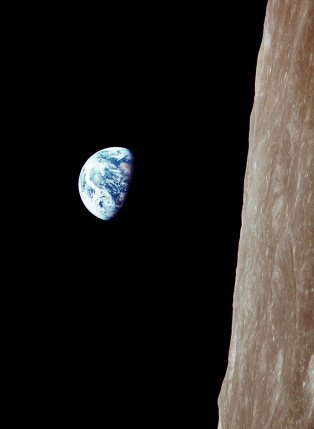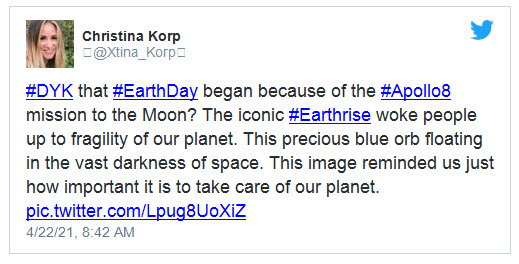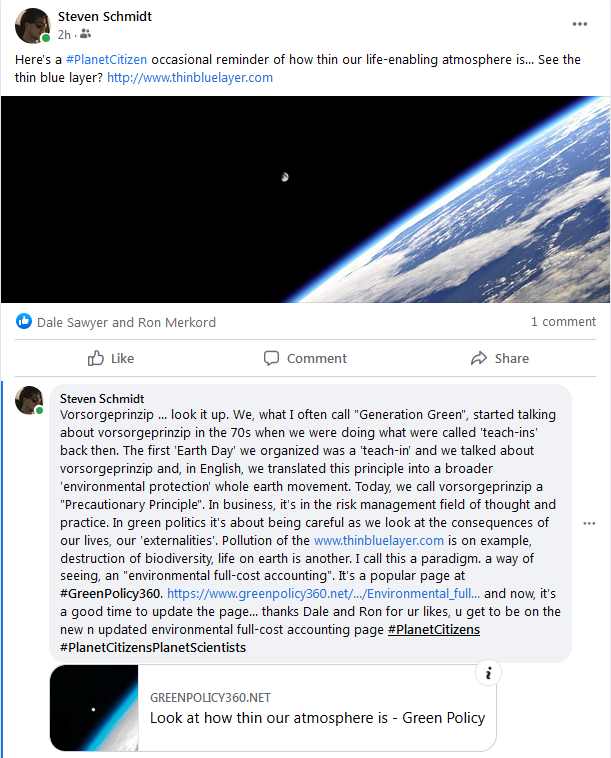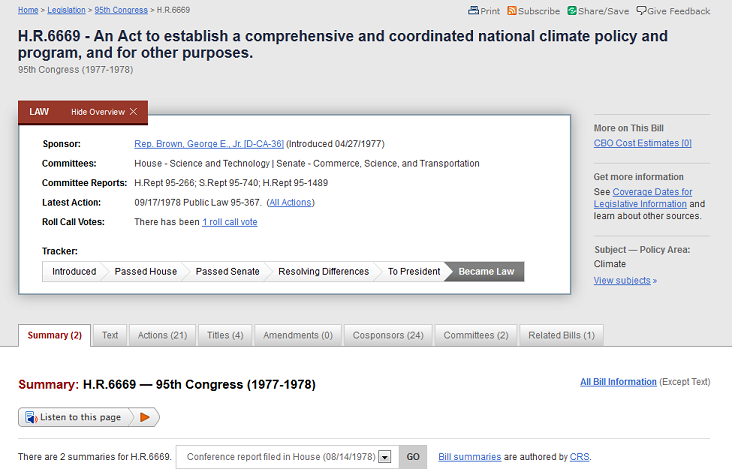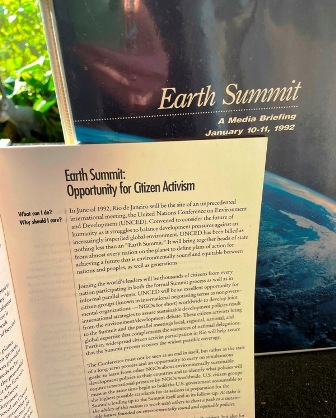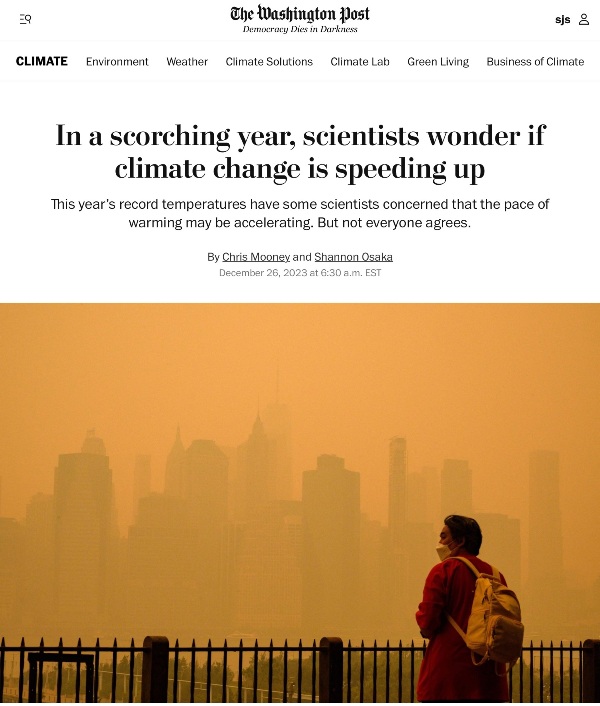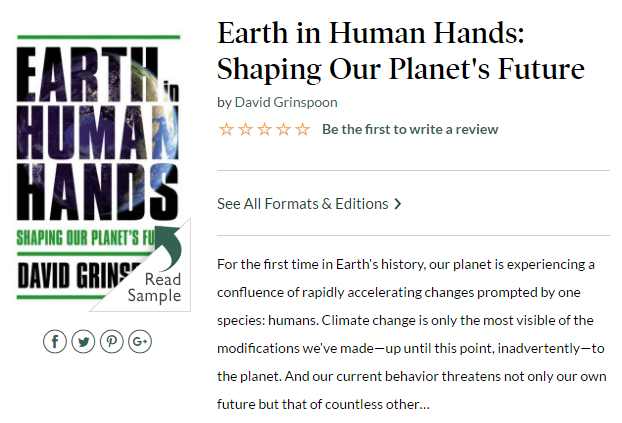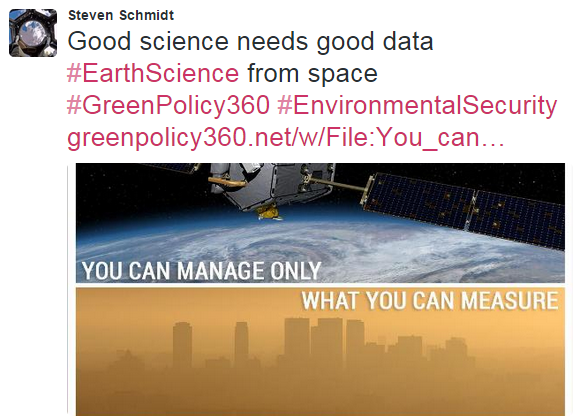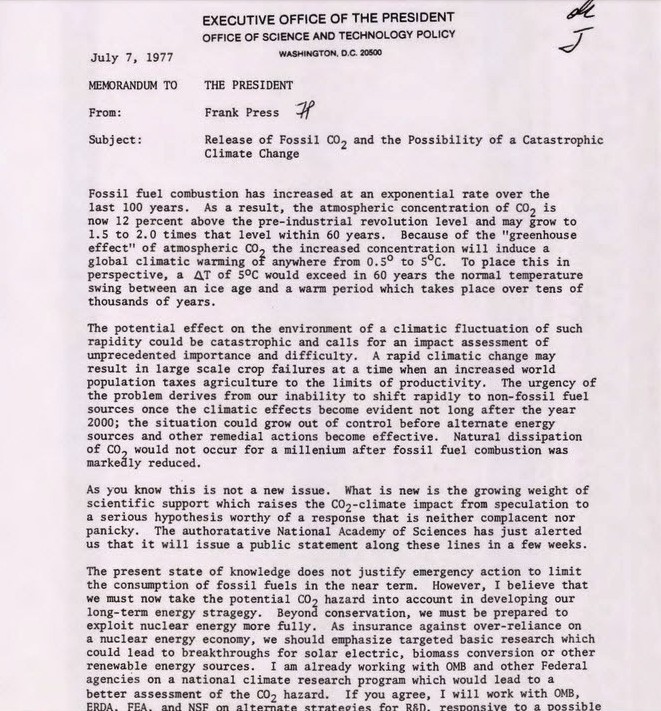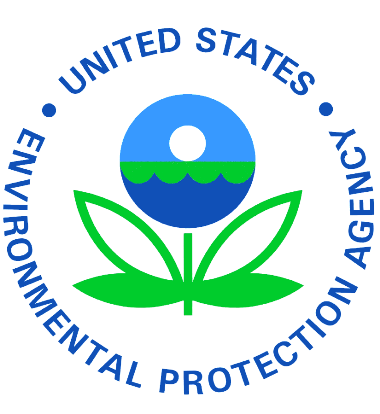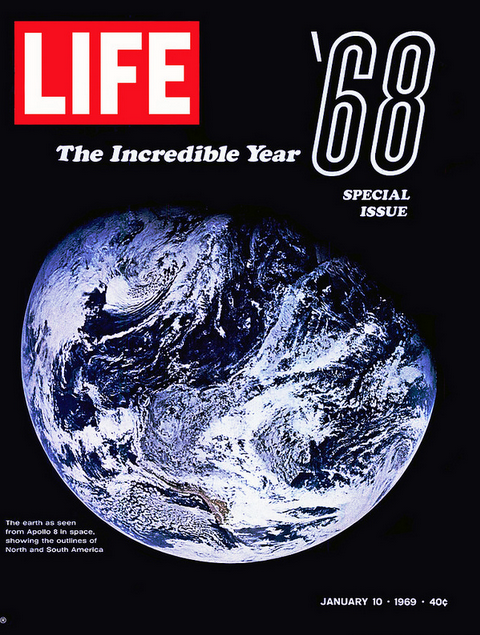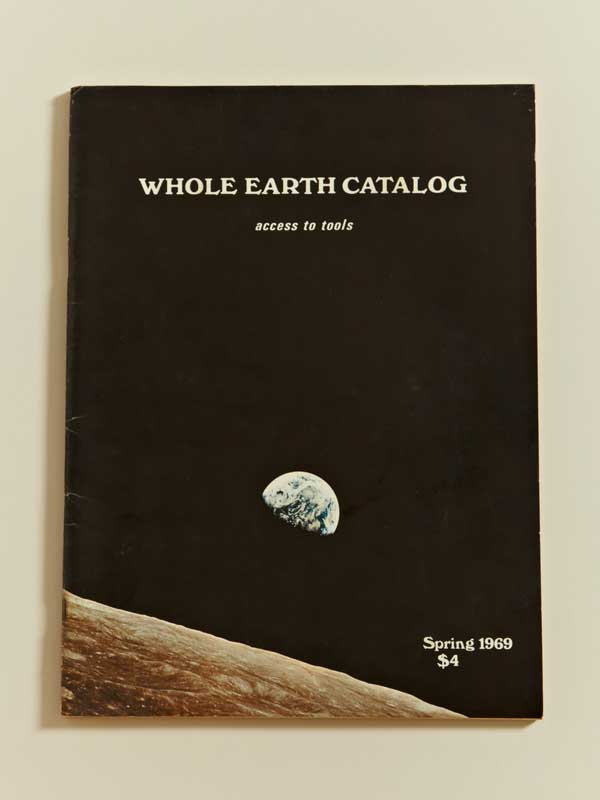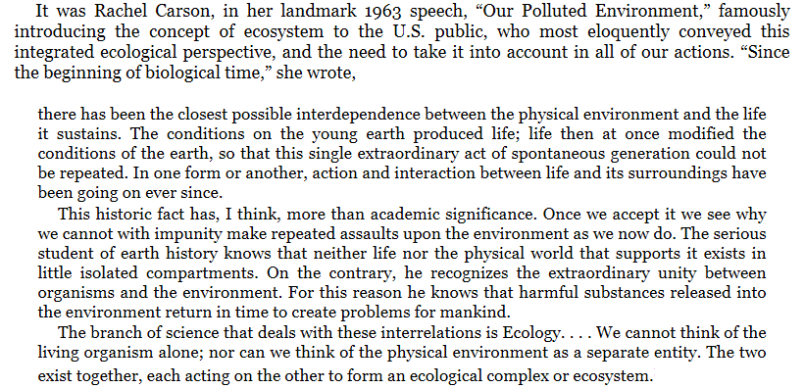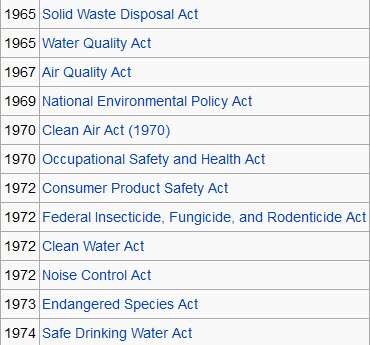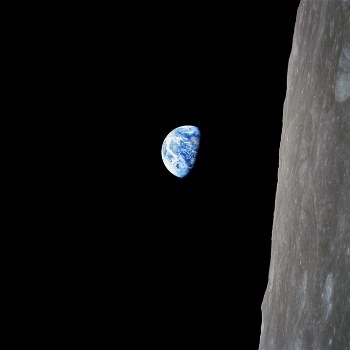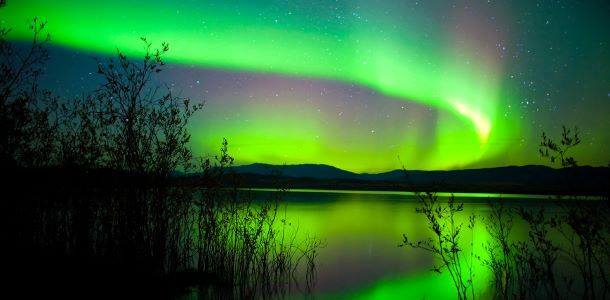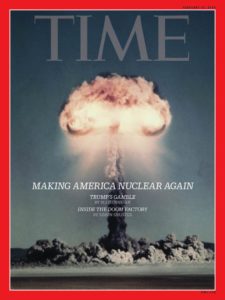Environmental movement: Difference between revisions
Siterunner (talk | contribs) No edit summary |
Siterunner (talk | contribs) No edit summary |
||
| (One intermediate revision by the same user not shown) | |||
| Line 223: | Line 223: | ||
:[[File:US Public Law 95-367.png]] | :[[File:US Public Law 95-367.png]] | ||
| | ||
🌎 | 🌎 | ||
| |||
<big>'''Ten Years On... 1988, the Climate Change Story Becomes News Headlines'''</big> | |||
: Jim Hansen testifies before the U.S. Senate | |||
[[File:Hansen-testimony-1988.jpg]] | |||
<small>* https://greenpolicy360.net/w/File:Hansen-testimony-1988.jpg</small> | |||
| |||
🌎 | |||
| |||
<big><big>'''1992 -- Earth Summit''' </big></big> | <big><big>'''1992 -- Earth Summit''' </big></big> | ||
Latest revision as of 14:53, 4 October 2024
- New Visions, Life-affirming 'Earthrise'
- December 1968, from the window of Apollo 8
- 'Earthrise' (1968) and 'Earth Day' (1970)
Beginnings of the Modern Environmental Movement
SJS / Siterunner: Against a backdrop of conflict, the 1960s gave rise to a burgeoning movement. Civil rights, free speech, anti-war and anti-nuclear weapons and catastrophe came to light. Across the world many young people and activists were moved to work for peace, nuclear weapons reduction, and social justice. In the U.S. the civil rights movement and nationwide civil rights action challenged racist politics. Environmentalism took on new forms and shapes with ideas that became a legal platform, a first generation of environmental laws that would go worldwide. A new "counterculture" with youthful vision and organizing added their voices and stood up to create the beginnings of a global environmental movement.
With a goal of protecting life, a new environmental movement began to grow, a "Whole Earth" vision seen for the first time from space in 1968 with the iconic Apollo 8 Earthrise image and a very real 'sense' of our common responsibility for the future of the planet. Students were 'first-movers' who spoke of the existential threat of nuclear war and environmental disaster, and need to 'become' far-reaching with a new vision. Realizations grew internationally that we had created weapons capable of ending humanity and most all life of earth -- and we needed to change this nuclear doomsday threat. Protests and 'teach ins', led by students, and drawing in politicians, communities, media, news with pamphlets, books, music, art and demonstrations crossed continents with new symbols, peace symbols, environmental and eco-awareness.
The threads of teach-ins led directly to and the first Earth Day in 1970 as students expanded counterculture with action. Across the U.S., a first Earth Day of teach-ins began as a student-initiated movement on college campuses including your siterunner's college where we proposed an environment and peace action day to Senator Nelson, who we met as we organized the national Moratorium and who worked with us to make an Earth Day a national political event. At the University of Southern California, our student peace activists continued 1969's anti-war moratorium sharing a positive vision of what was needed -- environmental protection, economic and social justice, new priorities added to the nation's agenda. The work spread quickly. Earth Day's teach-ins reached out to students globally. A worldwide environmental movement became a real and growing political force...
"I am convinced that the same concern the youth of this nation took in changing this nation's priorities on the war in Vietnam and on civil rights can be shown for the problems of the environment. Successful teach-ins on all campuses on the same day will have a dramatic impact on the environmental conscience of the nation. They will be immensely effective as an educational effort in arousing public opinion..."
- -- Senator Nelson, April 23, 1970 at the University of Southern California
SJS / Siterunner: As a student activist at the University of Southern California, I looked at inviting Senator Gaylord Nelson to USC for the first Earth Day as a natural thing to do. We were organizing what became the first Earth Day as an extension of our peace work and vision-shifting, first-ever images of Planet Earth. We proposed an Earth Day event amid what the Senator called the "rumblings", as many of us in the student movement organized optimistically with our new 'whole Earth' vision.
The profound issues of the 1960s, civil rights, and the war in Vietnam were our 'coming of age' story and we dealt with what we called "the big picture". This, in turn, led to seeing with new eyes, with planetary awareness. It became a time for looking ahead and alternatives to politics-as-usual and business-as-usual. The modern environmental movement sprang forward and, on April 22nd, we raised a first Earth Day flag.
Earth Day flag
Steven Schmidt, GreenPolicy360 Siterunner
- DYK? Yes, we do know, we remember the beginnings
- We were there. We experienced and lived it...
On the 50th Anniversary, 2020
Memories on the Road to the First Earth Day
- Personal and Up Close
- By Steve Schmidt
Earth Day to Every Day
·········································
2024 ... 50+ Years On...
Our story continues to this day. We, now at GreenPolicy360, are continuing on, presenting Earth science news, green politics and environmental movement recollections and highlights from the eco-journey:
The numbers are in, and scientists can now confirm what month after month of extraordinary heat worldwide began signaling long ago. Last year was Earth’s warmest by far in a century and a half.
Global temperatures started blowing past records midyear and didn’t stop. First, June was the planet’s warmest June on record. Then, July was the warmest July. And so on, all the way through December.
Averaged across last year, temperatures worldwide were 1.48 degrees Celsius, or 2.66 Fahrenheit, higher than they were in the second half of the 19th century, the European Union climate monitor announced on Tuesday. That is warmer by a sizable margin than 2016, the previous hottest year.
·······················································
New Ways to See & Experience Planet Earth
Visit GreenPolicy360's story of Earth Science research from our decades of research, eco-activism and #PlanetCitizens education.
Our eco operating system (eOS) includes:
ThinBlueLayer.com - Look at how thin our atmosphere is
New Definitions of National Security
Earth Science Research from Space
·····································
Flashback -- 1978, Climate Action Memories
- GreenPolicy360 Siterunner: Our friend George steps up in Congress
·······················································
First National Climate Act
GreenPolicy360 Siterunner / SJ Schmidt: The beginnings of modern environmental and climate science can be traced to the 1960s and 1970s. The U.S. National Academy of Sciences played a key role in laying a foundation of scientific reports and data.
Energy and Climate Report, 1977, National Academy of Sciences / 175 pp. / PDF via GreenPolicy360
Rep. George Brown took the findings of the 1977 Energy and Climate Report from the Academy of Sciences and made the science actionable. In a historic moment, he proposed and drafted the legislation of the first U.S. National Climate Program and shepherded its passage in 1978.
This first federal program established to study and assess scientifically the issues and risks of human-caused climate change became a foundation for comprehensive initiatives, with an array of new Earth Science missions led by NASA and NOAA, the EPA and USGS.
🌎
Ten Years On... 1988, the Climate Change Story Becomes News Headlines
- Jim Hansen testifies before the U.S. Senate
* https://greenpolicy360.net/w/File:Hansen-testimony-1988.jpg
🌎
1992 -- Earth Summit
- We reported 'deep on the first Earth Summit'...
- and worked to draft a 1992 US presidential campaign platform 'heavy on the green'
- Launch of Annual International Climate Conferences
🌎
2023
December 26, 2023
GreenPolicy360: We are reading this morning's Washington Post front-of-the-news online, and thinking how our story arc as planet citizens, planet scientists (as we've come to call eco activists like us) has a parallel to the WaPo climate news as 2023 comes to a close.
Let's pull a few quotes from the article, a wrap up review of climate and global warming this year, and predictions by three scientists and related commentary about that the numbers could be telling all of us about our common future.
One line stands out in particular -- The record shows that the pace of warming clearly sped up around the year 1970.
1970 was the year your GreenPolicy360 founder-siterunner was working to set up the first Earth day alongside a science-trained new Congressperson, George E. Brown. Together we were also attempting to bring 'Big Science', especially coordinated EarthPOV-Earth Science and Atmospheric Science into view, the data needed to make informed policy decisions which the Representative was leading and enabling with legislative initiatives, including the First National Climate Act.
Today, some 50+ years on, in a democratically debating world with databases and data resulting from all these years of science, observation, research, study and expertise at work, we as a species, globally connected humanity, are attempting how best to apply our Earth System Science knowledge base. The goal of having the necessary data and science informing us of Earth's dynamic, changing, living systems has been achieved to a significant degree.
We can say Earth is now in our hands. The question of questions is how will we act?
WaPo: Now, after what is poised to be the hottest year in recorded history, the same experts believe that it is already happening.
In a paper published last month, climate scientist James E. Hansen and a group of colleagues argued that the pace of global warming is poised to increase by 50 percent in the coming decades, with an accompanying escalation of impacts.
According to the scientists, an increased amount of heat energy trapped within the planet’s system — known as the planet’s “energy imbalance” — will accelerate warming. “If there’s more energy coming in than going out, you get warmer, and if you double that imbalance, you’re going to get warmer faster,” Hansen said in a phone interview.
Zeke Hausfather, a climate scientist with Berkeley Earth, has similarly called the last few months of temperatures “absolutely gobsmackingly bananas” and noted, “there is increasing evidence that global warming has accelerated over the past 15 years.”
But not everyone agrees. University of Pennsylvania climate scientist Michael Mann has argued that no acceleration is visible yet: “The truth is bad enough,” he wrote in a blog post.
GreenPolicy360:
In whatever perspective our readers see and experience human-induced climate change/global warming, and respond to environmental protection and climate challenges, we can say that our initial goal of recognizing a crisis-in-the-making and [https://www.greenpolicy360.net/w/New_Definitions_of_National_Security a new vision and changes to make informed decisions was set in motion.
Here we are.... What comes next in our story?
It's almost 2024. Time to keep on with the work planet citizens.
🌎
Atmospheric Science
- Earth Science to Protect & Preserve a Sustainable Earth
- Time to act to make a positive difference
Planet Citizens, Planet Scientists, Preserving & Protecting the Home Planet Earth
- From the original NASA Mission Statement: "To understand and protect our home planet"
GreenPolicy360 Siterunner / SJS: What is almost always overlooked when one talks about the first years of the modern environmental movement is the science, the new science of the environmental movement. Most all media from the era of the 60s and 70s seems to have missed what your GreenPolicy360 siterunner was experiencing first hand -- a history of ideas, a shift in paradigms as what is now called "earth science" and "atmospheric science" and "climate change" and "global warming" first came onto the radar.
When one looks at today's Earth Science Research from Space and accumulative science data acquired over the decades, we are seeing the results of a congressman from my home district, a man called George E. Brown. George became my friend and mentor and together for over 30 years we collaborated as George became a visionary leader in the U.S. House of Representative.
Here is a touch of what I've written about George's life -- George E. Brown Jr
Planet Citizen, Planet Citizens, and Planet Citizens, Planet Scientists at GreenPolicy360 are influenced directly by George Brown. As an engineer with a physics background, George knew we were responsible for the next generation. The environmental movement we were launching would need good scientific data to make the decisions guiding how we respond to the great challenges of our times, the existential threats on multiple fronts. Your GreenPolicy360 siterunner has continued to carry this message under under a banner of earth science. Today, our 21st century earth science missions are tapping into the data and scientific results of programs designed to produce the knowledge base George Brown knew would be needed to make wise and even fateful decisions. Whether we make the necessary decisions is up to our generation, every generation has a 'generational responsibility'. We, at GreenPolicy360, see rising challenges all of us must face, as Planet Citizens acting with vision...
- Earth System Science: 'Measuring to Manage' our planet's living, changing systems
GreenPolicy360's founder was fortunate, beginning in the 1960s, to listen to Congressman Brown Congressman George E. Brown point to the NASA planning and explain how he saw Congress put into action the reality of a multi-year, coordinated, multi-agency atmospheric/earth science program to achieve mission goals. Earth science, measuring and monitoring Earth's life-enabling systems was given highest priority. Landsat's program was set in motion as a decades long, first-ever digital scanning remote satellites data collecting study. An array of satellites began to launch, creating and combining the expanding resources of NASA, USGS, NOAA, and an array of educational and scientific institutions and aeronautics business.
The overall goal, Representative Brown would continue to explain in his Congressional Science, Space & Technology leadership roles over the decades, was to understand, preserve and protect our planet as we, humanity, develop the science to look beyond the Earth and study 'the heavens'.
Here's to George Brown and the many visionaries, thinkers and doers who have carried on preserving and protecting our home planet.
As George and I worked with him over many years we both grew in our politics as we worked together for peace and environmental protection. Big science was at the center of much of George's future-looking agenda. He believed in green politics and was a mentor to me and many. He became a leader in Congress from California who helped shape the modern environmental movement.
Today many of the actions of George Brown continue as models for citizens, cities and nations of the world. California and a green political/environmental protection movement that George helped to begin continue to be out in front with ideas to improve quality of life.
In our GreenPolicy360 work, George's work continues. Even as political opposition to environmental work, anti-nuclear work, anti-war work is at risk, as we look out at a strategic horizon with pressing demands, the foundations put in place by an earlier generation remain strong.
Planet Citizen Action | Climate Problems, Climate Solutions
George Brown's work remains with us in his legacy of accomplishment. I miss him often but know he is still around. I feel him when I write of green ideas and look to our kids and education and our shared future...
Let's look at some of what George accomplished before his untimely passing in 1999:
George was instrumental in proposing and establishing the Presidential Office of Science and Technology Policy in 1976. He was working alongside the National Academy of Sciences as they released a first-ever climate report in 1977. In 1977 he and the new Office of Science and Technology sent a first government warning of "climatic fluctuation" and "catastrophic" change to President Carter:
GreenPolicy360
- "Greening Our Blue Planet"
On a Green 50th Anniversary
Memories on the Road to the First Earth Day
• https://www.greenpolicy360.net/w/Earth_Day_Memories_on_the_50th_Anniversary
······························
George was a key player in legislation founding the Environmental Protection Agency.
As the LA Times noted (without pomp or circumstance) in George's obituary in 1999: "He championed the creation of the federal Environmental Protection Agency". The creation of the EPA was in many ways Congressman George Brown's vision achieved..."
The U.S. Environmental Protection Agency Looks Back at Origins
* https://www.epa.gov/history * https://www.epa.gov/history/origins-epa * https://www.epa.gov/history/historical-photos-and-images * https://www.epa.gov/history/historical-environmental-topics#historical * https://www.epa.gov/history/epa-order-100027-epa-history-program
The result of Congressional initiative and Reorganization Plan to bring together federal agencies and programs to study, monitor and protect the health and well-being of people and the environment, the U.S. Environmental Protection Agency was established on July 9, 1970; it began operation on December 2, 1970.
Earlier, in December 1969, Congress passed the National Environmental Policy Act (NEPA), a bill intended to "create and maintain conditions under which man and nature can exist in productive harmony" and to "assure for all Americans safe, healthful, productive, aesthetically and culturally pleasing surroundings."
NEPA required any federal agency planning a project that would affect the environment to submit a report on the likely consequences of its plan.
A "Whole Earth" movement was born as citizens of planet Earth looked up and looked back and saw, for the first time, majestic real-time pictures of home.
Years later, the Environmental Protection Agency published its history, including these notable phrases:
"By late 1969, the subterranean rumblings heralding the impending explosion could already be heard... "Suddenly out of the woodwork come thousands of people talking about ecology."
"It was at just this time that Congress sent to the President a remarkable bill known as the National Environmental Policy Act (NEPA). Senator Gaylord Nelson (D-Wis) -- looking back at the "Environmental Decade" in 1980 -- called NEPA "the most important piece of environmental legislation in our history."
Senator Gaylord Nelson recalls that right after the passage of NEPA, "the issue of the environment exploded on the country like Mount St. Helens."
National Environmental Policy Act
"The Magna Carta of the country’s national environmental laws..."
····························································
"When the astronauts turned their cameras homeward in December 1968, capturing first images of a blue planet, the world looked upon itself with awe and new whole-Earth understanding..."
···································································
In Memory of Rachel Carson, "Ecosystems" and Her Eye-Opening Science
······································································
🌎 A Modern Environmental Movement Is Born
File:1969 beginnings of the modern environmental movement.pdf
California and Environmental Politics in the US Congress: Out in Front
Green Appreciation for the Vision & Leadership of Two Browns from California -- 'George & Jerry'
California "Out in Front"
SJS / Siterunner: As many of us in the late 1960s on college campuses looked to the future, we began to press politicians to join with us in environmental protection. Young political leaders like California's Jerry Brown and George Brown joined in with the new environmental movement. I personally was fortunate to work with Jerry and George in many ventures, including envisioning and drafting of first green legislation. Jerry was soon to become Governor and earn the moniker of "Governor Moonbeam" for his visionary ideas, and George became a key leader in national science policy, becoming Chair of the science/technology/space committee in the US House of Representatives. Initiatives were put before presidents and Congress and passed due to overwhelming public support. 'Out in front' vision became models (as with many of GreenPolicy's green best practices network models) for cities/states/nations across the globe over the decades. The 1960s/70s/80s formative environmental years are a living legacy. Looking back we continue to see a platform of ideas and vision, a foundation that we are building on ...
Environmental Policy Laws: The Beginnings of a New Era
- ··········································································
································································
The First National Climate Program Act
(Legislation Passed in 1978, key drafter/sponsor Representative George E. Brown (D), East Los Angeles)
National Climate Program Act, Public Law 95-367
National Climate Program Act of September 1978
In 1979 came the first follow-on National Science Academy climate science report. This study and report of national scientists was prescient and accurate in its global warming predictions.
··············································
Historic Climate Studies
GreenPolicy360: Go back to the beginning of climate science. Let us look at the work of Congressman George E. Brown and the Office of Science and Technology Policy - 1977
Beginnings of U.S. Climate Policy / National Climate Program Act - 1978
Energy Use & Climate Impact, National Academy of Sciences Study - 1977
Now let's look at what the fossil fuels industry, ExxonMobil, was examining and not revealing...
In 1982, in a climate science study that was not released to the public, ExxonMobil predicted that by 2019 the Earth's atmospheric CO2 level would reach about 415 parts per million, raising the global temperature roughly 0.9 degrees C.
In fact, the world crossed the 415 ppm threshold in 2019 and broke 0.9 degrees C in 2017.
Read More:
Exxon: The Road Not Taken
After eight months of investigation, InsideClimate News presented this history of Exxon’s engagement with the emerging science of climate change. The story spans four decades, and is based on primary sources including internal company files never before seen, interviews with former company employees, and other evidence.
It describes how Exxon conducted cutting-edge climate research decades ago and then pivoted to work at the forefront of climate denial, manufacturing doubt about the scientific consensus that its own scientists had confirmed.
○
Unprecedented environmental protection bills began a process that continues to this day...
Green, environmental public policies, a foundation on which to build sustainable quality of life...
Wikipedia / Environmental Policy of the United States
Water quality act
http://www.encyclopedia.com/article-1G2-3456400109/water-quality-act-1965.html
Air quality act http://scholarship.law.duke.edu/cgi/viewcontent.cgi?article=3197&context=lcp
National environmental policy act http://en.wikipedia.org/wiki/National_Environmental_Policy_Act
Clean air act (extended 1970) https://www.gpo.gov/fdsys/pkg/STATUTE-84/pdf/STATUTE-84-Pg1676.pdf
Occupational safety and health act http://en.wikipedia.org/wiki/Occupational_Safety_and_Health_Act
Consumer product safety act http://en.wikipedia.org/wiki/Consumer_Product_Safety_Act
Federal insecticide, fungicide and rodenticide act http://www.epa.gov/agriculture/lfra.html
Clean water act http://en.wikipedia.org/wiki/Clean_Water_Act
Noise control act http://en.wikipedia.org/wiki/Noise_Control_Act
Endangered species act http://www.fws.gov/endangered/laws-policies/
Safe drinking water act http://water.epa.gov/lawsregs/guidance/sdwa/basicinformation.cfm
·····················································································
Whole Earth
Origins of the modern environmental movement: Earthrise opens our eyes to who we are
Popular culture begins to see the big picture
Buckminister Fuller in 1968, published “Operating Manual for Spaceship Earth.” He called us earth 'astronauts' and we listened and he described how our planet needs continued 'maintenance' in order to keep operating successfully. Earlier, Ray Bradbury in Los Angeles, another creative and visionary 'imagineer' who profoundly influenced students in my generation, had created a new literary term -- Spaceship Earth. We could see the big picture now, a Whole Earth planet flying thru space with us as 'pilots'.
Together, Fuller and Bradbury, influenced Walt Disney (if you can imagine) to create the centerpiece of a new Disneyworld of the future, Epcot, a geodesic story told of Spaceship Earth.
Read the original design script for Spaceship Earth. I was there to report Epcot's unveiling in Florida. -- Your GreenPolicy360 siterunner
File:RAY BRADBURY Spaceship Earth - Epcot - 1977.pdf
Circa 1969 --- We are spaceship Earth...
○ ○ ○ ○ ○ ○ ○ ○ ○ ○ ○ ○ ○ ○ ○ ○ ○
The Apollo 8 Earthrise Photo
○
On December 21, 2018, the 50th anniversary of the Apollo 8 launch...
• https://www.greenpolicy360.net/w/File:Apollo.jpg
• http://www.bbc.com/future/story/20181220-the-nasa-mission-that-broadcast-to-a-billion-people
• https://qz.com/1501935/photos-apollo-8-brought-us-the-moon-as-never-seen-before/amp/
• https://petapixel.com/2018/12/20/how-nasas-iconic-earthrise-photo-was-shot/
Today, fifty years on, Bill Anders says that the most striking image to him was not the Earth as seen from the moon, so much as it was the Earth receding in the distance as they left it behind on their outbound voyage. Arguably, that view has changed us — colored our attitude toward the environment, international affairs, our place in the universe—more than Apollo’s other accomplishments.
“It took a while to affect me,” Anders says, “this beautiful blue ball against the darkest black you could imagine, getting smaller and smaller as we went. It made me realize how insignificant our little planet was.”
http://www.greenpolicy360.net/w/File:Apollo_Earth_350x350.jpg
○
1972, a Whole Earth exclamation point, Apollo 17's image of "Blue Marble" Planet Earth
http://www.greenpolicy360.net/w/Apollo_17
···································································
In Memory of George -- and Virginia
- New Ways of Seeing Our World
- An Intergenerational Legacy
Rep. George E. Brown
Virginia Tower Norwood
LANDSAT and Virginia Tower Norwood
···································································
In Memory of David Brower and His Dreams of Changing the World
David Brower quoting Goethe -- “Whatever you can do or dream you can, begin it. Boldness has genius, power and magic in it!”
SJS / Siterunner recalling one of David's favorite quotes as we worked on Green Education projects together with Danny Moses of Sierra Club books.
Recalling David, shortly before his death in 2000, flying to Denver, Colorado, to attend the Green Party's presidential nominating convention and the approval of the founding Green Platform. In an interview: "Ralph is doing what we need to do if we really care about the planet... I'm old... but I'm relying on a lot of young people..." One of David's last acts was to cast his absentee ballot for Ralph.
- ····································
In Memory of Aldo Leopold and His Life Affirming Story of the 'Green Fire'
http://aldoleopold.org/greenfire/about.shtml
······················································
Planet Citizens... an Ongoing Environmental Movement
https://www.greenpolicy360.net/w/Category:Civil_Liberties
https://www.greenpolicy360.net/w/Category:Civil_Rights
https://www.greenpolicy360.net/w/Category:Human_Rights
https://www.greenpolicy360.net/w/Category:Environmental_Laws
https://www.greenpolicy360.net/w/Category:Clean_Air
https://www.greenpolicy360.net/w/Category:Clean_Water
https://www.greenpolicy360.net/w/Category:Environmental_Protection
https://www.greenpolicy360.net/w/Category:Eco-nomics
https://www.greenpolicy360.net/w/Category:Alternative_Agriculture
https://www.greenpolicy360.net/w/Category:Food
https://www.greenpolicy360.net/w/Category:Earth_Day
https://www.greenpolicy360.net/w/Category:Green_Politics
https://www.greenpolicy360.net/w/Category:Global_Security
https://www.greenpolicy360.net/w/Category:Renewable_Energy
https://www.greenpolicy360.net/w/Category:Green_Business
https://www.greenpolicy360.net/w/Ecofeminism
https://www.greenpolicy360.net/w/Category:Rights_of_Nature
https://www.greenpolicy360.net/w/Rights_of_Nature_EarthLaw
https://www.greenpolicy360.net/w/Category:Sustainability_Policies
·············································································
Menton, France, 1970
A peace & reconciliation movement looking to the peoples of the world and speaking to protection of life and the commons, Earth's environment connecting all
The Message from Menton was followed by a second gathering at the time of the U.N. Summit on the Human Environment in Stockholm, Sweden, 1972.
- Via Wikipedia | The Stockholm Declaration of 1972, or the Declaration of the United Nations Conference on the Human Environment, is the first UN declaration on the global environment. It consists of 26 principles and led to the creation of the United Nations Environment Programme (UNEP), which laid the foundation for future global environmental governance. The United Nations Conference on the Human Environment was held in Stockholm, Sweden, from June 5–16 in 1972. The 1972 United Nations Conference on the Human Environment signifies the first international effort to place environmental issues at the forefront of global concerns. The Conference sought to recognize the finite nature of Earth's resources and human impacts on the environment. It represented the beginning of a global dialogue on the link between economic growth, the pollution of the environment, and the well-being of humanity. The resulting Stockholm Declaration urged its partnering nations to reduce air, land, and water degradation by integrating science and technology in their development plans. It also called nations to create regulations on wildlife protection, environmental conservation, and population control. While the reception of the ideas in the Declaration generally stayed positive, it received wide criticisms on its practical implementation, especially from developing nations.
············································································································
Green Politics: At the Frontlines of Anti-Nuclear Weapons Politics
- The 1960s on, Green/Environmental Politics working toward a safer, sane world
Nuclear Weapons, Nonproliferation v. Proliferation
························································
Warnings from Jonathan Schell
In 2007, the late Jonathan Schell spoke presciently about the relationship between nuclear weapons and climate change:
“When I wrote The Fate of the Earth in 1982, I said that, first and foremost, nuclear weapons were an ecological danger. It wasn’t that our species could be directly wiped out by nuclear war down to the last person. That would only happen through the destruction to the underpinnings of life, through nuclear winter, radiation, ozone loss.
There has been an oddity of timing because when the nuclear weapon was invented, people didn’t even use the word ‘environment’ or ‘ecosphere.’ The environmental movement was born later. So in a certain sense the most urgent ecological threat of them all was born before the context in which you could understand it. The present larger ecological crisis in that context.
In other words, global warming and nuclear war are two different ways that humanity threatens to undo the natural underpinnings of human, and of all other, life... we may be in a better position today because of global warming, to grasp the real import of nuclear danger.”
The Fate of the Earth
·························································
The Environmental Movement Carries On
The Fate of the Earth Is At Stake
Our Calling Is Clear
- Additional Website Resources - Linked Data - Green Best Practices
- Anthropocene
- Atmosphere
- Atmospheric Science
- Biodiversity
- Clean Air
- Clean Water
- Democracy
- Digital Rights
- Earth
- Earth Day
- Earth Science
- Earth360
- EarthPOV
- Eco-nomics
- Eco-Quotes
- Eco-Spirituality
- Ecology Studies
- Ecotourism
- Education
- Energy Policy
- Environmental Laws
- Environmental Movement
- Environmental Protection
- Environmental Security
- EOS eco Operating System
- Forests
- GreenPolicy360
- Green Best Practices
- Green Energy Initiatives
- Green Networking
- Green Party
- Green Politics
- Green Values
- Health
- Human Rights
- Media
- Natural Resources
- Networking
- Nuclear Nonproliferation
- Oceans
- Ocean Science
- Online Education
- Peace
- Planet Citizen
- Planet Citizens
- Planet Citizens, Planet Scientists
- Renewable Energy
- Resilience
- Social Justice
- Strategic Demands
- Sustainability
- Sustainability Policies
- US Environmental Protection Agency
- Water Quality
- Whole Earth
- World Wide Web
- Youth
